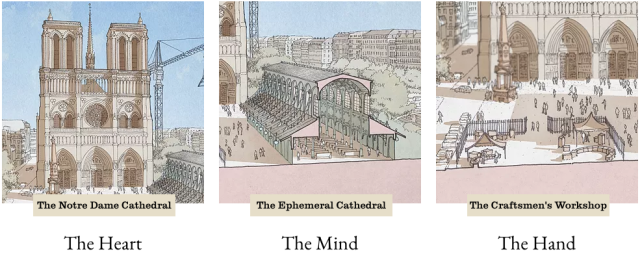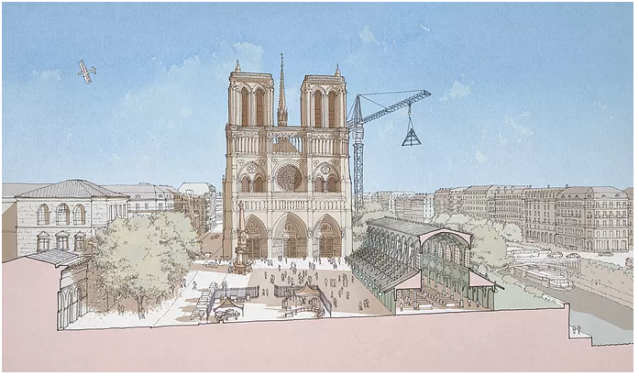
The as yet officially unannounced international design competition on how to repair Notre-Dame de Paris after her extensive damage by fire has already spawned a number of predictably ridiculous proposals. One would replace the roof with a swimming pool intended, it would appear, to collapse what the fire did not. Another proposal comes from Sir Norman Foster.
One proposal that eschews the ridiculous, called “A Vision for Notre Dame,” has emerged from three young architects who met at Notre Dame – that is, in architecture school at the University of Notre Dame in South Bend, Ind. – and now all work in Atlanta. Two of them, Rene Salas and Jacques Levet, are at Historical Concepts and Reinaldo Hernandez is at Peter Block Architects. Paul Knight, of Historical Concepts, who sojourned in Providence early this decade, has helped spread their idea as expressed in the proposal:
Our Hands need our Minds, guided by the Heart. We support the full restoration of Notre Dame as it stood prior to the tragic fire. Our proposal focuses on how the site surrounding Notre Dame can be used during the restoration process. The rebuilding of Notre Dame should be a public process and the site should convey the important meanings of what has existed there, the traditions that contributed toward its development, and the people that materialized and crafted it.
No doubt every proposal intends to restore (or “restore”) the cathedral. Although the forces arrayed against replication are far from insignificant – modernist architecture is a cult as powerful in France as in America – the likelihood is that the spire and roof will be reproduced consonant with their pre-catastrophe appearance. The institutional forces pushing back against a modernist reconceptualization include the cathedral’s status as a UNESCO World Heritage site (described by its former heritage director, Francesco Bandarin), France’s conservation community, and the organized artisans who still know how to do the work. France’s workers are quite capable of exerting pressure on its government (which, by the way, owns Notre-Dame).

The workplace of the “Vision.”
So that is heartening. But if the restoration of Notre Dame is to reach its greatest significance, it must contribute to a trend toward beauty that may have its heart in Paris but exists throughout the world. The reconstruction of the cathedral must feed momentum toward a global revival of tradition in architecture. Fortunately, the “Vision for Notre Dame” proposal appears perfectly capable of embracing that mission.
Notre Dame’s restoration should engage the public in that effort. In addition to restoring the cathedral and building a temporary communal building, the “Vision” contemplates erecting a craftsmen’s workshop in the square facing the cathedral. The workshop would introduce the public to the work of hand that reflects the values of construction that have atrophied in recent decades dominated by the bogus “machine age” metaphor that has ripped the heart out of architecture. “Relearning the lessons of history, and the wisdoms of culture,” the proposal reads, “will strengthen our abilities to conceptualize a more dignified and human habitat. The progress of society is inseparable from the traditions that we chose to maintain.” In short:
“How many young people will be inspired by what they may see?”
Precisely. Reconstructions of major historic civic, institutional, commercial and ecclesiastical buildings and squares, and new places designed in the spirit that once made cities great, have been proceeding in Europe and elsewhere for decades. The reconstruction of Dresden’s Frauenkirche district and the construction of a popular new town, Poundbury, in the style of old Britain epitomize both sides of that equation. In the United States, new buildings that recapture beloved old styles are increasingly common (most recently the federal courthouse of Tuscaloosa, Ala., in the style of a Greek temple). No project promises to engage the public’s imagination like that of rebuilding Penn Station as originally designed. (“One entered the city like a god,” said Vincent Scully after its demolition. “One scuttles in now like a rat.”)
Architecture is inherently slow, difficult work, as are the preservation and reconstitution of culture and tradition. But it can be done and should be done. It is likely that if Notre Dame is rebuilt in a mere five years, it will be an epic fail. That must not happen.
Work on Notre Dame may be expected to stir a popular yearning for beauty and grandeur in our cities, and not just in Paris. Coming from Atlanta, with its Millennium Gate, “A Vision for Notre Dame” would add boosters to this aspiration for a renewed pride in place that has taken all too many years to regenerate. Let’s wish “Vision” well in the upcoming competition.




Wonderful idea. Thanks so much for passing it along!
LikeLike
I would assume that Viollet-le-Duc’s drawings still exist so that replication of the fleche and any other elements designed by him would be fairly easy.
LikeLike
I like the idea of restoring the close city environment that ND was meant to have. This is my attempt at how to do this
LikeLike
Very evocative, Peter. Thank you so much for sending it to me. I understand that houses and other buildings long ago huddled up to the cathedral. When did this change? Was it done by Voillet-le-Duc, or by Baron Haussmann? What is the status of scary proposals from City Hall to redevelop parts of the Isle de la Cite now that the judicial workers have been carted off to their ugly new headquarters tower? Or have they?
LikeLike
I couldn’t see Peter’s video because I’m blocked from viewing it in Italy “due to copyright reasons”… Whatever – I like the idea. Of course it was Haussmann who cleared out the Isle de la Cité and turned Notre Dame into a showpiece freestanding object.
LikeLike
I hope I may be allowed to express my pride in these students, two of whom I taught at Notre Dame (in Indiana). All three have gone on to well-deserved success in the profession and their efforts on this proposal for Notre-Dame (in Paris) show that a commitment to the values of beauty, sustainability, and justice, coupled with a well-informed imagination, can make a difference. Now if they can solicit the interest and support of the folks at the Campagnonage du Devoir, the successors of the medieval craft guilds that originally built the cathedral, they may just be able to make this happen, and probably for less than the billion euros raised so far. Congratulations Rene, Jacques, and Reinaldo!
LikeLiked by 1 person
I’m so glad, Steve, that I’ve had the opportunity to support this amazing trio from ND, and I hope I’ll get to write more about their proposal as the competition begins.
LikeLike
Indeed – a magnificent and perfectly appropriate, modern solution!
LikeLike
What a lovely idea. It far surpasses anything that the famous have proposed.
LikeLike
I’m sure there will be many fine entries, Eric, but how will the competition whittle them down? It will be easy to omit the Sir Normans but how to decide between what I imagine will be a majority of entries that, in one way or another, propose to rebuild the roof and spire in some degree as they were before. I am, to be frank, worried about how they do this, and how it might push them to instead select one of the bozo options. I of course may be off base in assuming that most French want a replication, that the forces against a modernist proposal are as strong as they are, and that the modernists don’t already have a lock on what is about to happen. Very scary!
LikeLike